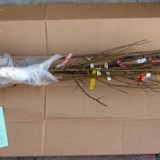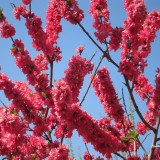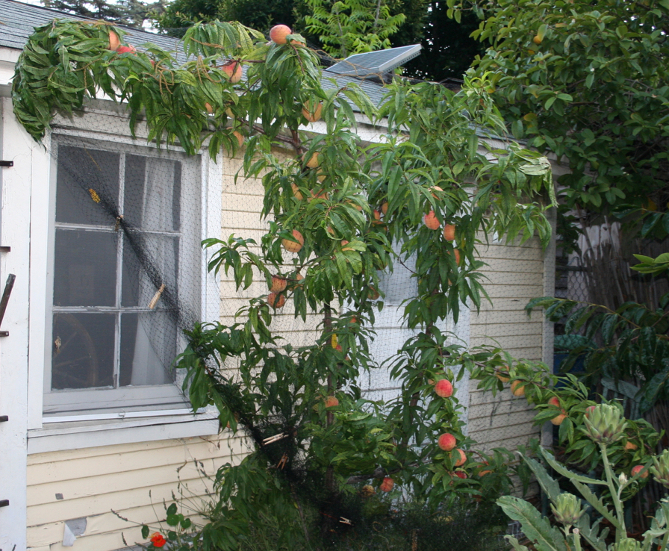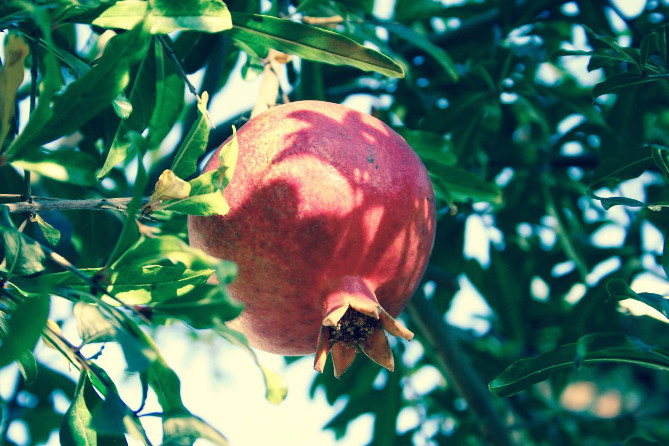
If I could only have one tree I think it might be a pomegranate. Why?
- Pomegranate trees have beautiful, bright red flowers in the spring and handsome yellow leaves in the fall.
- They grow fast.
- They have few pests.
- They are drought tolerant.
- They produce delicious fruit.
- Require low chill hours.
- They live long–200 years or more.
The big downside for, probably, most of the readers of this blog is that pomegranates are frost sensitive. And the fruit will split if it rains in the fall. But if you live in a warm, dry climate you need to get one!
The variety we have is Wonderful, not all that exciting as this is the variety at the supermarket. If I had to plant one again I’d probably choose a more exotic pomegranate. That said, Wonderful is still wonderful–big, juicy and delicious.
The time to order your bare root fruit trees is now! Our favorite source, Bay Laurel has a nice selection of pomegranates. Just order now for winter delivery, as they sell out. Pomegranates can also be propagated easily from cuttings and, along with figs and olives, are just about the only fruit trees that aren’t grafted.
Do you have a pomegranate tree? What variety do you have?






All of the above would explain why I saw so many pomegranates in CA yards! I’ve never wanted one, because I do not like the taste of pomegranete. Sometimes it feels like I must be the only one who doesn’t like them!
I’m not a huge fan of the taste either! But I love the look of them.
I have a pomegranate at my house on drip irrigation and my parents have one at their house that’s on flood irrigation. Mine was planted 2 years before theirs and they are both the wonderful variety. My tree is small (6′ tall X 4′ wide) and the fruits are small, their tree is over 15′ tall and about as wide and the fruit is the size of the ones that you pay $3 a piece for in the grocery store and it’s loaded with them every year!
We make grenadine syrup, we make pomegranate mead (about 6# of juiced seeds to a 5 gal batch), or just run them through the food mill and drink the juice straight up, we pick the seeds and vacuum seal bags and bags for the freezer, they are great on salads, awesome trees!
I have whatever the neighbor down the street has- he gave me a cutting six or seven years ago, and now I get dozens of tasty fruits every fall.
I have a hedge of Wonderful poms down one side of our property that I propagated from cuttings, which was very easy. Unfortunately, the critters have discovered them this year so I may not get much of a harvest. The Wonderful bushes are much more vigorous and productive than my one Eversweet bush. I don’t know if that’s common, or just the case here.
A word of caution – there’s YouTube out there with an extension agent (from a non-pom producing state, I believe) who says you can juice the fruit in a steam juicer by just breaking it up and not removing the rind. DO NOT DO THIS. The tannin in the rind will ruin your juice! You can remove the sarcotestas (with seeds) and steam juice them to make a nice product, or juice the halved fruits in a squeeze type orange juicer. Just try to minimize contact with the rind and don’t break open the seeds – they have tannin too. The rinds can be used as a dye mordant and I think also as a stand-alone dye.
The fruits will keep a while before juicing, so we always enjoy them as a decoration before we process them. All in all, a great plant for our climate.
Donna–thanks for the tips!
Aw, ya really had to go and bring a term like “sarcotestas” into a friendly conversation!
We have an Angel Red pomegranate and I think the flavor is much better than Wonderful and a bit sweeter. Our tree, which is barely 3 years old produced at least 20 good sized fruits this year. Hopefully next year we’ll have enough fruit to eat out of hand and juice for pomegranate jelly (a family tradition).
The other night my gardener friend, who has pomegranate tree, brought me some fresh-squeezed juice. It was heavenly – pleasantly tart, flavorful, and – above all – smooth. After I polished it off, I took a sip of my store-bought organic pomegranate juice to compare – so rough and metallic-tasting. Like following up a fine cabernet with a cheap zinfandel.
It’s too cold here for a pomegranate tree, but some of the growers from the valley bring them up here to the farmer’s market, and I love them. One farm grows a variety that has yellow skin and pale pink seeds. It’s much sweeter and less tart than the red skin/deep red seed kind, but delicious, and mixing the two types of seeds is especially good.
How I wish I could grow a pomegranate tree. And an avocado tree is an even bigger dream. Pennsylvania says no, though. I must be content with apple trees and my potted citrus that comes inside in winter!
At my house in South Texas, I have two pomegranate trees that are about three years old. They are on drip irrigation. The blooms are beautiful, but the fruits never ripen. They do get a slight blush to them, and then they crack open and insects crawl in. I have tried picking them before they develop cracks, but they are green inside and useless for eating. Even the ones that crack open aren’t ripe. They get twice-yearly fertilizing with an organic fruit tree fertilizer.
Any ideas?
First guess–does it rain when the fruit is on the tree where you live?
It seldom rains here. We are in a serious drought here. The only significant water that the trees get (and it’s not excessive) is from the drip irrigation.
Just went to UC Davis for more information. They say that fruit splitting can also be caused by either over-watering or under-watering.
We are going to plant one this year! We love in San Diego and I was going to go with the tried and true Wonderful, but now you’ve got me thinking about planting a different variety. Tell us, if you were to do it over, which would you plant and why?
Well, there’s nothing wrong with Wonderful if that’s where you end up–it’s a good plant– but we’d probably be more adventurous if we could do it again. Problem is we don’t have access to other types of poms to be able to sort out the fine differences. Our neighbor Lora really likes her Ambrosia, which is somewhat sweeter than Wonderful. I guess it would come down to what you want out of the fruit. If we were to do it over, we’d study the listings in the Bay Laurel catalog and randomly pick something more exotic, because why not?
Note the rec for Angel Red above, too.
This plant is really unruly, was wondering if you have photos or how-to video on what a properly trimmed Pom plant looks like.
Left unruly this plant does great as deterrence from burglars and even critters.
Poms are fast growers and have those terrible thorns, making pruning a necessity and a challenge. I don’t have a video for you, but it is possible to train them into a tidy tree form (ie single trunk) if you stay on top of them when they’re young. At the Getty Villa here they have some nice old poms which appear treelike and well behaved. However, it’s natural form is more like a sprawling shrub, with multiple trunks, which indeed can grow into a deadly screen against intruders and critters. I don’t think there’s a “proper” form for a pom–just a form which works for the setting.
We’ve let ours develop 3 trunks and a more sprawling, bush-like shape. I’m not entirely happy with it, but the shape is due to our bickering–Erik doesn’t like to see the pom cut, because he loves it so much. It makes him nervous when I approach it with clippers. I would have opted for the single trunk myself, but now it is too late. I work mostly on keeping the basic 3 trunk shape, and preventing the tree from taking over the yard.
As to what we do–basically, every year, after it drops its leaves I lop off all the new sucker growth–that is, the long straight shoots which grow straight up from the base of the tree and the branches–which is always epic! This is absolutely necessary, and can’t be skipped for even one year or madness will ensue. Then I trim the soft new growth back by a couple of feet, as it always gets quite long, and then I look at the overall structure of the tree, the shape of the major branches, and decide if any steps need to be taken. For instance, woody growth might be heading out straight across our walkway–that can’t happen, so I’ll cut back that branch.
The good news about pruning poms is that they are very resilient, and fast growers. I’d say be fearless with the pruning.
I whole-heartedly agree with the first sentence! At the Permaculture Learning Garden in downtown Las Vegas we have Eversweet and Wonderful pomegranate trees. They are hardy and produce like crazy, even without direct irrigation! Love these trees.
We have more than enough rain where I live and plenty of frost. So many of the things you grow, just won’t make it here.
On highway 126, pass Fillmore towards Santa Paula, if heading towards Ventura, theres a couple of avocado farms that have old looking pomegranate trees planted along its perimeter to either act as windbreak and/or fencing.
I’ve seen similar set-up around the Visalia farm area as well, heading to Kings-Sequoia nat’l parks, ‘cept they surround nectarines and peaches.
It’s sad to see around this time or later, when driving thru highway 126, so many big red pomegranates on the ground.
It’s a fast highway, so I’ve always been reluctant to just stop and pick-up the fruits, also not really familiar with protocol for stopping and picking fruits from the highway.
I am looking for edible prickly hedge plants and the Pom seems like a good choice. Are there varieties that are more shrub like?
Hey Seth! I’m no pom expert, but in my experience poms naturally want to be shrubs–making them into trees is the hard part! I think you could make a formidable hedge out of any pom you like.
Not that I’m aware of, but you can trim them to keep them a manageable height. They are prickly (big thorns) and very beautiful. In addition to the red fruit they have pretty flowers in the spring and a nice show of yellow leaves in the fall.